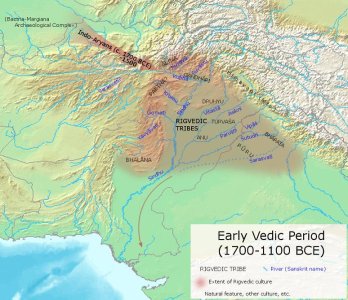"pAkIsTaNiS aRe tHe sAmE aS iNdIaNs"
Seriously if you don't have any background in the history of the Indus Valley, then don't talk like you know what you're talking about. You're only going to end up embarrassing yourselves further.
Genetic variations between Europe, Middle East, Central Asia and Indus Valley.
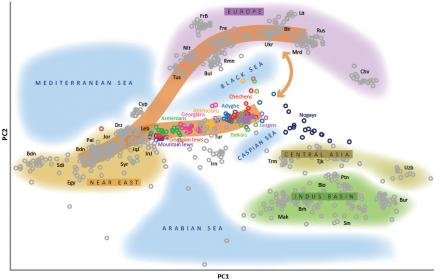
Photo: Consensus Neighbor-Joining Tree of Populations. The thickest edges have at least 95% bootstrap support, and the edges of intermediate thickness have at least 75% support. If all of the groups subtended by an edge have majority membership in the same cluster in Figure 2A (or only plurality membership in the cases of Hazara , Makrani, and Uygur), the edge is drawn in the same color as was used for the cluster.

Photo: Population Structure Inferred from Microsatellite and Insertion/Deletion Polymorphisms. Representative estimate of population structure for Pakistan. The plot represents the highest-likelihood run among ten STRUCTURE runs with K = 7 clusters.
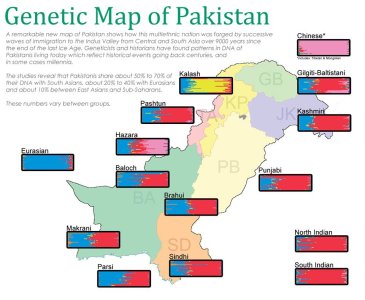
Photo: Results of ADMIXTURE analysis (K8) of world populations with a zoom-in on Iranian, Parsis, Pakistanis and other South Asian populations.
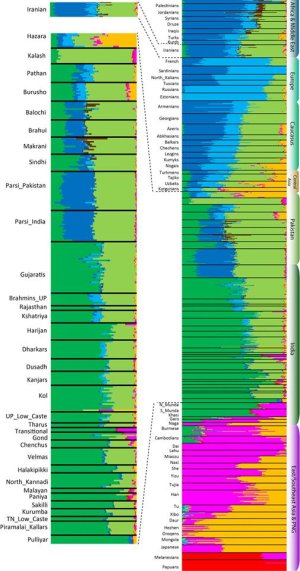
Sources:
-
http://journals.plos.org/plosgenetics/article?id=10.1371/journal.pgen.0020215
-
https://genomebiology.biomedcentral.com/articles/10.1186/s13059-017-1244-9
The “Genetic Journey of Pakistan” illustrates how the genetic makeup of Pakistan’s various ethnic groups was forged by successive waves of immigration from Central Asia and South Asia since the end of the last Ice Age. Throughout its long ancient history, the Indus Valley has been known welcome different peoples, faiths and cultures. The Indus was a region that our early human ancestors encountered soon after they left Africa between 50,000 to 70,000 years ago. Evidence of these early humans can be found throughout Pakistan today at Soan, Riwat, Makli Hill, Bajaur and Sanghao. Approximately 9000 years ago they began establishing cities such as Mehrgarh, which eventually expanded to represent the Harappan culture (Indus Valley Civilization) in 3000 BCE, rivaling the early city-states of Mesopotamia. Shortly after the fall of the Harappan civilization in 1500 BCE, a massive migration is said to have taken place from Eurasia to the Indus Valley, known today as the Aryan migration theory. This eventually led to the formation of the Vedic civilization by 1200 BCE. After 500 BCE, the Indus Valley would come under the influence of the Achaemenid Persians, Alexander’s Macedonian Empire, Greeks, Buddhists (Mauryans), Central Asians (Sycthians, White Huns), Mongols, Iranians, Arabs and Turks.
It was through these various influences by which our nation would be forged into its multi ethnic society today. Pakistanis are divided genetically into 11 distinct groups: Baloch, Brahui, Burusho, Hazara, Kalash, Kashmiri, Makrani, Parsi, Pashton, Punjabi and Sindhi. Other groups are also being investigated at present such as the Kho (Chitrali) and Baltis. The studies show that these ethnic groups share about 40% to 60% of their DNA with South Asians, about 40% to 60% with Eurasians and about 20% to 40% with East Asians, West Asians or Sub-Saharan Africans. These percentages vary between various ethnic groups and subgroups.
~ Kalash people ~
The Kalash people represent an enigmatic isolated population of Indo-European speakers who have been living for centuries in the Hindu Kush mountain range. Genetic analysis of Y-chromosome DNA (Y-DNA) by Firasat et al. (2007) on Kalash individuals found high and diverse frequencies of these Y-DNA Haplogroups: L3a (22.7%), H1* (20.5%), R1a (18.2%), G (18.2%), J2 (9.1%), R* (6.8%), R1* (2.3%), and L* (2.3%). Genetic analysis of Mitochondrial DNA (mtDNA) by Quintana-Murci et al. (2004) stated that "the western Eurasian presence in the Kalash population reaches a frequency of 100%" with the most prevalent mtDNA Haplogroups being U4 (34%), R0 (23%), U2e (16%), and J2 (9%). The study asserted that no East or South Asian lineages were detected and that the Kalash population is composed of western Eurasian lineages (as the associated lineages are rare or absent in the surrounding populations). The authors concluded that a western Eurasian origin for the Kalash is likely, in view of their maternal lineages. A study of ASPM gene variants by Mekel-Bobrov et al. (2005) found that the Kalash people of Pakistan have among the highest rate of the newly evolved ASPM Haplogroup D, at 60% occurrence of the approximately 6000-year-old allele. The Kalash also have been shown to exhibit the exceedingly rare 19 allele value at autosomal marker D9S1120 at a frequency higher than the majority of other world populations which do have it. A study by Rosenberg et al. (2006) employing genetic testing among the Kalash population concluded that they are a distinct (and perhaps aboriginal) population with only minor contributions from outside peoples. In one cluster analysis with (K = 7), the Kalash formed one cluster, the others being Africans, Europeans, Middle Easterners, South Asians, East Asians, Melanesians, and Native Americans. A study by Li et al. (2008) with geneticists using more than 650,000 single nucleotide polymorphisms (SNP) samples from the Human Genome Diversity Panel, found deep rooted lineages that could be distinguished in the Kalash. The results showed them clustered within the Central/South Asian populations at (K = 7). The study also showed the Kalash to be a separated group, having no membership within European populations. The estimates by Qamar et al. of Greek admixture has been dismissed by Toomas Kivisild et al. (2003) stating that "some admixture models and programs that exist are not always adequate and realistic estimators of gene flow between populations ... this is particularly the case when markers are used that do not have enough restrictive power to determine the source populations ... or when there are more than two parental populations. In that case, a simplistic model using two parental populations would show a bias towards overestimating admixture".[41] The study came to the conclusion that the Kalash population estimate by Qamar et al. "is unrealistic and is likely also driven by the low marker resolution that pooled southern and western Asian–specific Y-chromosome Haplogroup H together with European-specific Haplogroup I, into an uninformative polyphyletic cluster 2". A study by Firasat et al. (2006) concluded that the Kalash lack typical Greek Haplogroups such as Haplogroup 21 (E-M35). Previous Y chromosome and mitochondrial DNA markers provided no support for their claimed Greek descent following Alexander’s invasion of this region in 330 BCE, and analysis of autosomal loci provided evidence of a strong genetic bottleneck. The studies show that the Kalash share genetic drift with the Paleolithic Siberian hunter-gatherers and might represent an extremely drifted ancient northern Eurasian population that also contributed to European and Near Eastern ancestry. Since the split from other South Asian populations, the Kalash have maintained a low long-term effective population size (2319–2603) and experienced no detectable gene flow from their geographic neighbours in Pakistan or from other extant Eurasian populations. The mean time of divergence between the Kalash and other populations currently residing in this region was estimated to be 11,800 (95% confidence interval = 10,600−12,600) years ago, and thus they represent present-day descendants of some of the earliest migrants into the Indus Valley from Western Asia.
~ Hazara people ~
The Hazara people sample set showed a total of 189 distinct haplotypes, belonging mainly to West Eurasian (51.72%), East & Southeast Asian (29.78%) and South Asian (18.50%) haplogroups. Compared with other populations from Pakistan, the Hazara population had a relatively high haplotype diversity (0.9945) and a lower random match probability (0.0085). The dataset has been incorporated into EMPOP database under accession number EMP00680. The data herein comprises the largest, and likely most thoroughly examined, control region mtDNA dataset from Hazaras of Pakistan. Genetically, the Hazara are a mixture of western Eurasian and eastern Eurasian components. While it has been found that "at least third to half of their chromosomes are of East Asian origin, PCA places them between East Asia and Caucasus/Middle East/Europe clusters". Genetic research suggests that the Hazaras cluster closely with the Uzbek population, while both groups are at a notable distance from Tajik and Pashtun populations. There is evidence of both a patrimonial and maternal relation to Turkic Peoples and Mongols. Mongol male and female ancestry is supported by studies in genetic genealogy as well, which have identified a particular lineage of the Ychromosome characteristic of people of Mongolian descent ("the Y-chromosome of Genghis Khan"). This chromosome is virtually absent outside the limits of the Mongol Empire except among the Hazara, where it reaches its highest frequency anywhere. These results indicate that the Hazara are also characterized by very high frequencies of eastern Eurasian mtDNAs at 35%, which are virtually absent from bordering populations, suggesting that the male descendants of Genghis Khan, or other Mongols, were accompanied by women of East Asian ancestry. Women of Non-eastern Eurasian mtDNA in Hazaras are at 65% most which are West Eurasians and some South Asian The most frequent paternal Haplogroup type found amongst the Hazara was haplogroup C-M217 at 40% (10/25) with Haplogroup O3 (Y-DNA) at 8% (2/25) both which are Eastern Eurasian males ancestry associated with the Mongoloid ethnicity.
~ Brahui people ~
Brahuis display a variety of Y-DNA haplogroups, the most important being haplogroup R1a1a-M17 (35% to 39.09%) – with its mass diffusion among populations of Central and South Asia and associated with the early eastern migrations of Indo-Iranian nomads. Haplogroup J, which is found among other South Asian people, occurs at 28%. Other, relatively minor, low frequency haplogroups among the Brahui are those of G, L, E1b1a, and N. These haplogroups show that the Brahui population genetics are indistinguishable from those of neighboring Indo-Iranian speakers, in particular of that of the Baloch. Given the high affinity of Brahui to the other Indo-European Pakistani populations and the absence of population admixture with any of the examined Indian Dravidian groups, we conclude that Brahui are an example of cultural (linguistic) retention following a major population replacement. Hence, while the Brahui are ethnically an Indo-Iranian group, they speak a language with a Dravidian origin.
~ Makrani people ~
The Makrani people show a high genetic diversity (0.9688) and, consequently, a high power of discrimination (0.9592). The results revealed a strongly admixed mtDNA pool composed of African haplogroups (28%), West Eurasian haplogroups (26%), South Asian haplogroups (24%), and East Asian haplogroups (2%), while the origin of the remaining individuals (20%) could not be confidently assigned. The analysis also found that the Makranis studied share ancestry with peoples living in modern Kenya, Tanzania (Zanzibar) and South Africa, and with members of the Baloch people. The Asian and African ancestral groups are estimated to have begun mixing genetically about 300 years ago. Owing to their African ancestry, a large proportion of Makranis carry DNA variants common in Africa that protect against malaria infection.
~ Burusho people ~
The Burusho, also known as the Hunza or Botraj, live in the Hunza and Nagar valleys of Gilgit–Baltistan. A variety of Y-DNA haplogroups are seen among certain random samples of people in Hunza. Most frequent among these are R1a1 and R2a, which probably originated in either South Asia, Central Asia or Iran and Caucasus. R2a, unlike its extremely rare parent R2, R1a1 and other clades of haplogroup R, is now virtually restricted to South Asia. Two other typically South Asian lineages, haplogroup H1 and haplogroup L3 (defined by SNP mutation M20) have also been observed from few samples. Other Y-DNA haplogroups reaching considerable frequencies among the Burusho are haplogroup J2, associated with the spread of agriculture in, and from, the neolithic Near East, and haplogroup C3, of Siberian origin and possibly representing the patrilineage of Genghis Khan. Also present at lower frequency are haplogroups O3, an East Eurasian lineage, and Q, P, F, and G. DNA research groups the male ancestry of some of the Hunza inhabitants with speakers of Pamir languages and other mountain communities of various ethnicites, due primarily to the M124 marker (defining Y-DNA haplogroup R2a), which is present at high frequency in these populations. However, they have also an East Asian genetic contribution, suggesting that at least some of their ancestry originates north of the Himalayas. While genetic evidence supports a 2% Greek genetic component among the Pashton ethnic group of Pakistan, it does not support any for the Burusho.
~ Kho people ~
The Kho are an Indo-Aryan ethnolinguistic group associated with the Dardistan region. They speak Khowar (Chitrali), which is a member of the Dardic subgroup of the Indo-Aryan language family. Most Kho people live in the Chitral District of Khyber Pakthunkhwa, while others live in Jammu & Kashmir as well as in Badakhshan. Y-DNA haplogroup R1a (M420) is found at a high frequency among the Kho people. Many are in haplogroup R1b (M343), also found in some Central Asian and South Asian people.
~ Pashton people ~
The Pashton are the composite mosaic of West Eurasian ancestry of numerous geographic origins. They received substantial gene flow during different invasive movements and have a high element of the Western provenance. The most common haplogroups reported in this study are: South Asian haplogroups M (28%) and R (8%); whereas, West Asians haplogroups are present, albeit in high frequencies (67%) and widespread over all; HV (15%), U (17%), H (9%), J (8%), K (8%), W (4%), N (3%) and T (3%). Moreover, we linked the unexplored genetic connection between Ashkenazi Jews and Pashtun. The presence of specific haplotypes J1b (4%) and K1a1b1a (5%) pointed to a genetic connection of Jewish conglomeration in the Khattak tribe. This was a result of an ancient genetic influx in the early Neolithic period that led to the formation of a diverse genetic substratum in present day Pashton. The haplogroup R1a (Y-DNA) is found at a frequency of 51.02% among the Pashtun people. Paragroup Q-M242 (xMEH2, xM378) (of Haplogroup Q-M242 (Y-DNA)) was found at 16.3% in Pashtuns.
~ Sindhi people ~
The study of Sindhis was undertaken to investigate the control region of mitochondrial DNA for forensic discrimination and to explore the ethno-linguistic affiliations among ethnic groups of Sindh. A total of 115 individuals, from six major ethnic/isonym groups, namely, Bijarani, Chandio, Ghallu, Khoso, Nasrani and Solangi, were studied. The most common South Asian haplogroup in six ethnic groups of Sindh, were; M (42%) and R (6.9%), whereas West Eurasian haplogroups were N (6.9%), W (6.9%), J (1.7%), U (23.4%), H (9.5%) and T (0.86%). A random match probability between two unrelated individuals was found to be 0.06%, while genetic diversity varied from 0.991 to 0.998.
~ Punjabi people ~
The study of Punjabis was undertaken to investigate the control region of mitochondrial DNA for forensic discrimination and to explore the ethno-linguistic affiliations among ethnic groups of Punjab. However, only two groups were initially studied – the Arains and Gujars. Punjabi groups are primarily a composite of substantial South Asian, East Asian and West Eurasian lineages. A homogenous dispersal of Eurasian haplogroup uniformity in Punjab was found and exhibited a strong connotation with European populations. Moreover, for the first time the new sub-haplogroup M52b1 was characterized by 16223-T, 16275-G and 16438-A in the Gujar group. The vast array of mtDNA variants displayed in this study suggested that the haplogroup composition radiates signals of extensive genetic conglomeration, population admixture and demographic expansion that was equipped with diverse origin, whereas matrilineal gene pool was phylogeographically homogenous across the Punjab. This context was further fully acquainted with the facts supported by PCA scatterplot that Punjabi population clustered with South Asian populations. Finally, the high power of discrimination (0.8819) and low random match probability (0.0085%) proposed a worthy contribution of mtDNA control region dataset as a forensic database that considered a gold standard of today to get deeper insight into the genetic ancestry of contemporary matrilineal phylogeny.
~ Parsi people ~
Among present-day populations, the Parsis are genetically closest to Iranian and the Caucasus populations. They also share the highest number of haplotypes with present-day Iranians and it is estimated that the admixture of the Parsis with South Asian populations occurred 1200 years ago. Enriched homozygosity in the Parsi reflects their recent isolation and inbreeding. 48% South-Asian-specific mitochondrial lineages among the ancient samples was also observed, which might have resulted from the assimilation of local females during the initial settlement. Most surprisingly, Parsis are genetically closer to Neolithic Iranians than to modern Iranians, who have witnessed a more recent wave of admixture from the Near East. It has been suggested previously that the Islamic conquest had a major genomic impact on several Middle Eastern populations, including Iranians. Since Parsis diverged from Iranians just after this conquest, they may represent the genetic strata of Iran before the Islamic conquest.
~ Sources ~
-Kalash Genetic Isolate: Ancient Divergence, Drift, & Selection by Q. Ayub (2015)
-mtDNA sequence diversity of Hazara ethnic group from Pakistan by A. Rakha (2017)
-An Ethnolinguistic and Genetic Perspective on the Origins of the Dravidian-Speaking Brahui in Pakistan by L. Pagani (2017)
-Separating the post-Glacial coancestry of European and Asian Y chromosomes within haplogroup R1a by P.A. Underhill (2010)
-Y-Chromosomal DNA Variation in Pakistan by R. Qamar; Q. Ayub; A. Mohyuddin (2002)
-Whole genome sequencing of an ethnic Pathan (Pakhtun) from the north-west of Pakistan by M. Ilyas (2015)
-Genetic analysis of mitochondrial DNA control region variations in four tribes of Khyber Pakhtunkhwa, Pakistan by S. Bhatti (2016)
-Genetic characterization of the Makrani people of Pakistan from mitochondrial DNA control-region data by M.H. Siddiqui (2015)
-Mitochondrial DNA variation in the Sindh population of Pakistan by S. Bhatti (2015)
-Genetic perspective of uniparental mitochondrial DNA landscape on the Punjabi population, Pakistan by S. Bhatti (2017)
-“Like sugar in milk”: reconstructing the genetic history of the Parsi population by Gyaneshwer Chaubey











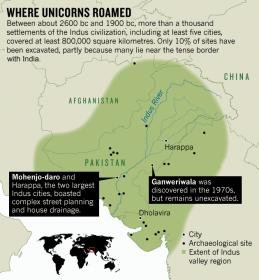
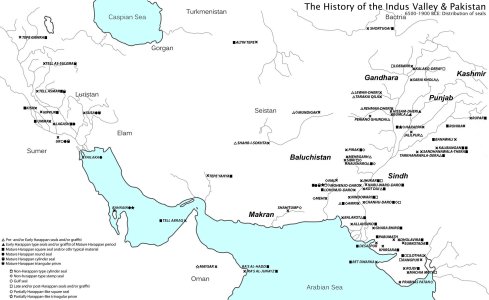
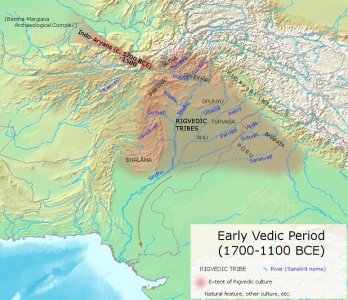
 :
:
